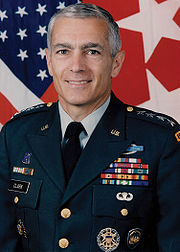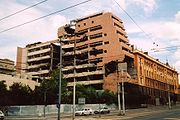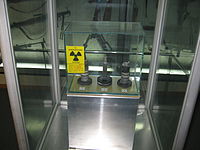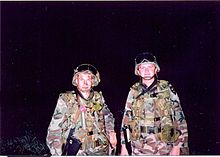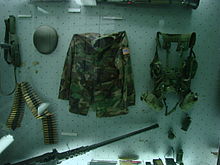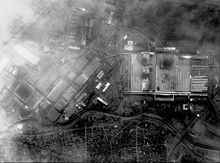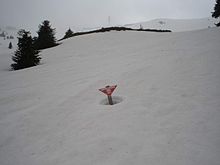- 1999 NATO bombing of Yugoslavia
-
"Allied Force" redirects here. For computer game, see Falcon 4.0: Allied Force.
Operation Allied Force Part of the Kosovo War 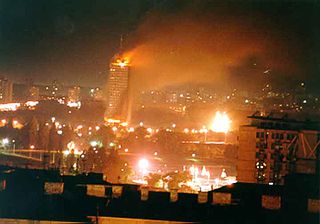
Ušće Tower on fire, 1999 Federal Republic of Yugoslavia.Date March 24, 1999 – June 10, 1999 (78 days)[1] Location Federal Republic of Yugoslavia,[2] mainly in the Republic of Serbia[3][4] Result Kumanovo Treaty UN Security Council Resolution 1244
- High civilian casualties for both the Albanians and Serbian minority in Kosovo and Serbian civilians in Yugoslavia
- Little damage inflicted on military targets
- Withdrawal of Yugoslav troops from Kosovo
- Deployment of KFOR
Territorial
changesNo legal border changes according to UN Resolution 1244, de facto separation of Kosovo from Yugoslavia under United Nations temporary administration Belligerents NATO forces
 United States
United States
 United Kingdom
United Kingdom
 Germany
Germany
 France
France
 Italy
Italy
 Canada
Canada
 Spain
Spain
 Portugal
Portugal
 Denmark
Denmark
 Norway[5]
Norway[5]
 Turkey[6]
Turkey[6]
 Netherlands
Netherlands
 Belgium
Belgium
and other NATO air, maritime and land forces FR Yugoslavia
FR Yugoslavia
Commanders and leaders  Bill Clinton
Bill Clinton
 Tony Blair
Tony Blair

 Javier Solana
Javier Solana

 Wesley Clark (SACEUR)
Wesley Clark (SACEUR)

 Rupert Smith
Rupert Smith Slobodan Milošević (Supreme Commander of the Yugoslav Army)
Slobodan Milošević (Supreme Commander of the Yugoslav Army)
 Dragoljub Ojdanić (Chief of Staff)
Dragoljub Ojdanić (Chief of Staff)
 Svetozar Marjanović (Deputy Chief of Staff)
Svetozar Marjanović (Deputy Chief of Staff)
 Nebojša Pavković (Commander of 3rd Army)
Nebojša Pavković (Commander of 3rd Army)Strength  Over 1,031 aircraft[7][8]
Over 1,031 aircraft[7][8]
 30 attack ships and submarines[9]
30 attack ships and submarines[9]
 Task Force Hawk
Task Force Hawk 114,000 regulars
114,000 regulars
 20,000 Yugoslav police
20,000 Yugoslav police
 15,000 volunteers
15,000 volunteers
 14 combat-capable MiG-29s[10]
14 combat-capable MiG-29s[10]
 46 combat capable Mig 21s
46 combat capable Mig 21s
 34 combat capable Soko J-22 Oraos
34 combat capable Soko J-22 Oraos
 1,400 artillery pieces
1,400 artillery pieces
 1,270 combat capable tanks
1,270 combat capable tanks
 825 combat capable armoured vehicles [9]
825 combat capable armoured vehicles [9]Casualties and losses  2 AH-64 Apaches
2 AH-64 Apaches
 2 soldiers killed in second AH-64 Apache crash outside combat[11][12]
2 soldiers killed in second AH-64 Apache crash outside combat[11][12]
 1 F-117A Nighthawk shot down[13][14]
1 F-117A Nighthawk shot down[13][14]
 2 A-10 Thunderbolt IIs damaged[15][16]
2 A-10 Thunderbolt IIs damaged[15][16]
 1 F-16C shot down[17][18][19]
1 F-16C shot down[17][18][19]
 1 AV-8B Harrier crashed[20]
1 AV-8B Harrier crashed[20]
 47 UAVs lost[21][22]
47 UAVs lost[21][22] 3 soldiers captured[23]
3 soldiers captured[23] 1,031 soldiers and police officers killed[24][25]
1,031 soldiers and police officers killed[24][25]
 299 soldiers wounded[26]
299 soldiers wounded[26]
 6 MiG-29s shot down or crashed, another 4 destroyed on the ground[10][27]
6 MiG-29s shot down or crashed, another 4 destroyed on the ground[10][27]
 1 J-22 Orao crashed[27]
1 J-22 Orao crashed[27]
 22 armored vehicles and artillery pieces destroyed in Kosovo, including 14 tanks[28]
22 armored vehicles and artillery pieces destroyed in Kosovo, including 14 tanks[28] Human Rights Watch was able to verify 500 civilian deaths throughout FR Yugoslavia (outside of Kosovo),[29][30] with other sources stating from 1,200 to 5,700.[29]
Human Rights Watch was able to verify 500 civilian deaths throughout FR Yugoslavia (outside of Kosovo),[29][30] with other sources stating from 1,200 to 5,700.[29]Operations
FR Yugoslav Strike Mission – Allied forceCamps
LapušnikMassacres
Panda Bar – Suva Reka – Velika Kruša – Gornje Obrinje – Cuska – RačakBattles
Prekaz – Belacevac Mine – Lodja – Podujevo – Junik – Glodjane – KošareIncidents
Albania-Yugoslav border incident
Pristina Airport Standoff –The NATO bombing of Yugoslavia (code-name Operation Allied Force or, by the United States, Operation Noble Anvil)[31] was NATO's military operation against the Federal Republic of Yugoslavia during the Kosovo War. The strikes lasted from March 24, 1999 to June 10, 1999. The NATO bombing marked the second major combat operation in its history, following the 1995 NATO bombing campaign in Bosnia and Herzegovina. The bombings led to the withdrawal of Yugoslav forces from Kosovo, establishment of UNMIK, a UN mission in Kosovo and put an end to the Yugoslav Wars of the 1990s. The bombing campaign was criticized, especially for the number of civilian casualties that resulted from the bombing.[32]
Contents
Goals
NATO's objectives in the Kosovo conflict were stated at the North Atlantic Council meeting held at NATO headquarters in Brussels on April 12, 1999:[33]
- An end to all military action and the immediate termination of violence and repressive activities by the Milosevic government;
- Withdrawal of all hostile military, police and paramilitary forces from Kosovo;
- Stationing of UN peacekeeping presence in Kosovo;
- Unconditional and safe return of all refugees and displaced persons;
- Establishment of a political framework agreement for Kosovo based on Rambouillet Accords, in conformity with international law and the Charter of the United Nations.
Michel Chossudovsky argued that the real objective was economic colonialization of Serbia.[34]
Strategy
Operation Allied Force predominantly used a large-scale air campaign to destroy Yugoslav military infrastructure from high altitudes. Ground units were not used because NATO wanted to minimize the risk of losing forces, as well as avoiding public criticism related to its relative ineffectiveness against mobile ground targets. After the third day, also known by NATO officials as, "Day 3," almost all of the strategic military targets of Yugoslavia were destroyed. But the Yugoslav Army still managed to keep standing and still attack Kosovo Liberation Army (KLA) insurgents that were still stationed inside Kosovo, mostly the regions of Northern and Southwest Kosovo. Strategic economic and society targets, such as bridges, military facilities, official government facilities, and factories, were bombed. Long-range cruise missiles were used to hit heavily defended targets, such as strategic installations in Belgrade and Pristina. Infrastructure such as power plants (using the BLU-114/B "Soft-Bomb"), water processing plants and the state-owned broadcaster were also targeted, making much more environmental and economic devastation all throughout Serbia and Kosovo.
The Kosovo War of 1999 has been subject to arguments over whether the capitulation of Yugoslavia was the result entirely of air power or that it occurred in conjunction with other factors.
Arguments for strategic air power
According to John Keegan the capitulation of Serbia in the Kosovo War marked a real turning point in the history of warfare. It "proved that a war can be won by air power alone." By comparison, diplomacy had been tried before the war but had not worked, and the deployment of a large ground force was still weeks away when Slobodan Milošević caved in.[35]
As for why air power should have been capable of acting alone, it has been argued that there are several factors required. These normally come together only rarely, but all occurred during the Kosovo War:[36]
- Bombardment needs to be capable of causing destruction while minimising casualties. This causes pressure within the population to end hostilities rather than prolong them. The exercise of precision air power in the Kosovo War is said to have provided this.
- The regime must be susceptible to pressure from within the population. As was demonstrated by the overthrow of Milosevic a year later, Serbia's government was only weakly authoritarian and was dependent upon support from within the country.
- There must be a disparity of military capabilities such that the opponent is unable to inhibit the exercise of air superiority over its territory. Serbia, a relatively small impoverished Balkan state, faced a much more powerful NATO coalition including the world superpower, the United States, and most of western Europe
- Carl von Clausewitz once called the 'essential mass of the enemy' as his "centre of gravity". Should the centre of gravity be destroyed, a major factor in Yugoslavian will to resist would be broken or removed. In Milosevic's case, the centre of gravity was his hold on power. He manipulated hyperinflation, sanctions and restrictions in supply and demand to allow powerful business interests within Serbia to profit and they responded by maintaining him in power. The damage to economy, which squeezed it to a point where there was little profit to be made, threatened to undermine their support for Milosevic if the air campaign continued, whilst causing costly infrastructure damage.[37]
Arguments against strategic air power
- Diplomacy:
- According to British Lieutenant-General Mike Jackson, it was Russia’s decision on June 3 to back the West and urge Milosevic to surrender that was the single event that had "the greatest significance in ending the war." The capitulation came the same day.[38] Russia was reliant on Western economic aid at the time, which made it vulnerable to pressure from NATO to withdraw support for Milosevic.[39]
- Milosevic’s indictment by the UN as a war criminal, even if it did not influence him in its own right, made the likelihood of Russia resuming diplomatic support less likely.[40]
- The Rambouillet Agreement prior to the war gave NATO forces the right of transit, bivouac, manoeuvre, billet, and utilisation across Serbia. By the time Milosevic capitulated, NATO forces were to have access only to Kosovo proper.[41]
- The international civil presence in the province was to be under UN control which allowed for a Russian veto should Serb interests be threatened.[42]
- Current ground operations – The KLA was undertaking operations in Kosovo itself and had some successes against Serb forces. A border post Morine near Yugoslav army outpost at Kosare in the north west of the province was abandoned by Yugoslav army. Although Yugoslav army outpost at Kosare hold on entire war this allowed for a supply line to be set up into the province and the subsequent taking of territory in the Junik area. The KLA also penetrated a few miles into the south western Mount Pastrik area. But most of the province remained under Serb control.[43]
- Potential ground attack – General Wesley Clark, Supreme Allied Commander Europe, was “convinced” planning and preparations for ground intervention "in particular, pushed Milosevic to concede."[44] His capitulation occurred on the same day that President Bill Clinton held a widely publicized meeting with his four service chiefs to discuss options for a ground force deployment in case the air war failed.[45] However, a ground offensive was vigorously opposed by France and Germany, and had been for some time, since April 1999. French estimates suggested it would need an army of 500,000 to achieve success. This left NATO, particularly the United States, with a clear view that a land operation had no support. With this in mind, the Americans reaffirmed their faith in the air campaign.[46] The reluctance of NATO to use ground forces casts serious doubt on the idea that Milosevic capitulated out of fear of a land invasion.[47]
Operation
On 23 March 1999 Richard Holbrooke returned to Brussels and announced that peace talks had failed.[48] Hours before the announcement, Yugoslavia announced on national television it had declared a state of emergency citing an imminent threat of war and began a huge mobilization of troops and resources.[48][49] On 23 March 1999 at 22:17 UTC the Secretary General of NATO, Javier Solana, announced he had directed the Supreme Allied Commander Europe (SACEUR), General Wesley Clark, to "initiate air operations in the Federal Republic of Yugoslavia."[49][50] On 24 March at 19:00 UTC NATO started the NATO bombing campaign against Yugoslavia.[51][52]
NATO operations
Wesley Clark served as the Supreme Allied Commander Europe (SACEUR)Yugoslav Ministry of Defence building damaged during NATO bombing1999 NATO bombingof Yugoslavia
Grdelica – Đakovica – Radio Television Serbia – Belgrade streets – Lužane – Niš – Novi Sad – Valjevo - Chinese embassy – KorišaNATO's bombing campaign involved 1,000 aircraft operating from air bases in Italy and Germany, and the aircraft carrier USS Theodore Roosevelt stationed in the Adriatic Sea. At dusk, F/A-18 Hornets of the Spanish Air Force were the first NATO planes to bomb Belgrade and perform SEAD operations. BGM-109 Tomahawk cruise missiles were fired from ships and submarines. The U.S. was the dominant member of the coalition against Yugoslavia, although all NATO members were involved. During the ten weeks of the conflict, NATO aircraft flew over 38,000 combat missions. For the German Air Force (Luftwaffe), this mission was its first conflict participation since World War II. In addition to air power, one battalion of Apache helicopters from the U.S. Army's 11th Aviation Regiment was deployed to help combat missions. The regiment was augmented by pilots from Fort Bragg's 82nd Airborne Attack Helicopter Battalion. The battalion secured AH-64 Apache attack helicopter refueling sites, and a small team forward deployed to the Albania – Kosovo border to identify targets for NATO air strikes.
The campaign was initially designed to destroy Yugoslavian air defences and high-value military targets.
NATO military operations increasingly attacked Yugoslavian units on the ground; as well as continuing the strategic bombardment. Montenegro was bombed several times, and NATO refused to prop up the precarious position of its anti-Milošević leader, Milo Đukanović. "Dual-use" targets, used by civilians and military, were attacked; the targets included bridges across the Danube, factories, power stations, telecommunications facilities, headquarters of Yugoslavian Leftists, a political party led by Milošević's wife, and the Avala TV Tower. Some protested that these actions were violations of international law and the Geneva Conventions. NATO argued these facilities were potentially useful to the Yugoslavian military and that their bombing was justified.
On April 14, NATO planes bombed an Albanian convoy near Đakovica, killing 73 refugees.[53] At the beginning of May, a NATO aircraft hit an Albanian refugee convoy, killing 50 people. NATO admitted the mistake five days later, and the Yugoslav media accused NATO of deliberately attacking the refugees. On May 14, NATO aircraft struck two convoys of ethnic Albanians near Koriša, killing about 100 refugees.[54]
On May 7, NATO bombed the Chinese embassy in Belgrade, killing three Chinese journalists. NATO claimed they were firing at Yugoslav positions. The United States and NATO apologized for the bombing, saying it occurred because of an outdated map provided by the Central Intelligence Agency. There have been reports citing unnamed sources (described as NATO personnel) that the attack was intentional. The reasons given for the attack vary, but include speculation it was an attempt to kill Yugoslav president Slobodan Milošević during a scheduled visit to the embassy and claims the embassy was being used as a re-broadcast station for Yugoslav military or paramilitary forces. Some accounts also describe those killed as intelligence operatives and not journalists, but both the US and Chinese governments maintain their original positions.[55][56][57] The bombing strained relations between the People's Republic of China and NATO, provoking angry demonstrations outside Western embassies in Beijing.[58]
NATO command organization
The Secretary General of NATO, Javier Solana, directed the Supreme Allied Commander Europe (SACEUR), General Wesley Clark, to "initiate air operations in the Federal Republic of Yugoslavia." Clark then delegated responsibility for the conduct of Operation Allied Force to the Commander-in-Chief of Allied Forces Southern Europe who in turn delegated control to the Commander of Allied Air Forces Southern Europe, Lieutenant-General Michael C. Short USAF.[59] Operationally, the day-to-day for responsibility for executing missions was delegated to the Commander of the 5th Allied Tactical Air Force.[60]
Yugoslav operations
 Brazda/Stenkovac I Refugee Assistance Centre in Macedonia. At its height this Centre housed over 50,000 refugees.[61]
Brazda/Stenkovac I Refugee Assistance Centre in Macedonia. At its height this Centre housed over 50,000 refugees.[61]
The Hague Tribunal ruled that over 700,000 Kosovo Albanians were forcibly displaced by Yugoslav forces into neighbouring Albania and Macedonia, with many thousands displaced within Kosovo.[62] By April, the United Nations reported 850,000 refugees had left from Kosovo.[63] Another 230,000 were listed as internally displaced persons (IDPs): driven from their homes, but still inside Kosovo. German Foreign Minister Joschka Fischer claimed the refugee crisis was produced by a Yugoslav plan codenamed "Operation Horseshoe".
Serbian Television claimed that huge columns of refugees were fleeing Kosovo because of NATO’s bombing, not Yugoslav military operations.[64][65] The Yugoslav side and its Western supporters claimed the refugee outflows were caused by a mass panic in the Kosovo Albanian population, and the exodus was generated principally by fear of NATO bombs.
The United Nations and international human rights organizations were convinced the crisis resulted from a policy of ethnic cleansing. Many accounts from both Serbs and Albanians identified Yugoslav security forces and paramilitaries as the culprits, responsible for systematically emptying towns and villages of their Albanian inhabitants by forcing them to flee.[66]
The cause of the refugee exodus formed the basis of United Nations war crimes charges against Slobodan Milošević and other officials responsible for directing the Kosovo conflict.
Air combat
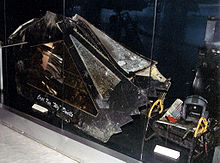 Canopy of F-117 shot down by the Yugoslav Air Force on March 27, 1999, near the village of Buđanovci, Serbia.
Canopy of F-117 shot down by the Yugoslav Air Force on March 27, 1999, near the village of Buđanovci, Serbia.
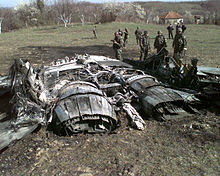 Wreckage of downed Yugoslav MiG-29 in Ugljevik on March 25, 1999.
Wreckage of downed Yugoslav MiG-29 in Ugljevik on March 25, 1999.
An important portion of the war involved combat between the Yugoslav Air Force and the opposing air forces. United States Air Force F-15s and F-16s flying mainly from Italian air force bases attacked the defending Yugoslav fighters; mainly MiG-29s, which were in bad shape, due to lack of spare parts and maintenance. Other NATO forces also contributed to the air war.
Air combat incidents:
- Night of March 24/25, 1999: Yugoslav air force scrambled five MiG-29s to counter the initial attacks. The two fighters that took off from Niš Airport were vectored to intercept targets over southern Serbia and Kosovo, were dealt with by NATO fighters: the MiG-29 flown by Maj. Dragan Ilić was damaged by an AIM-120 fired from a Dutch F-16AM fighter. He landed with one engine out and the aircraft was later expended as a decoy. The second MiG, flown by Maj. Ilijo Arizanov, was shot down by an USAF F-15C piloted by Lt. Col. Cesar Rodriguez. The pair from Batajnica Air Base (Maj. Nebojša Nikolić and Maj. Ljubiša Kulačin), were engaged by USAF Capt. Mike Shower who shot down Nikolić while Kulačin evaded several missiles fired at him while fighting to bring his malfunctioning systems back to working order. Eventually realizing that he could not do anything, and with Batajnica AB under a severe attack, he diverted to Belgrade international airport, and landed safely, his aircraft temporarily concealed under a tail of a parked retired airliner.[67] The fifth and last MiG-29 to get airborne that night was flown by Maj. Predrag Milutinović. Immediately after take-off his radar failed and electrical generator malfunctioned. Shortly after, he was warned by SPO-15 of being acquired, but he evaded the opponent by several evasive manoeuvres. Attempting to evade further encounters he approached Niš Airport intending to land when he was hit by an 2K12 Kub in a friendly fire incident and forced to eject.[68]
- Morning, March 25: Maj. Slobodan Tešanović stalled his Mig-29 while landing on Ponikve Airbase after a re-base flight. He ejected safely.[69]
- During the war Yugoslav strike aircraft J-22 Oraos and G-4 Super Galebs performed some 20–30 combat missions against the KLA in Kosovo at treetop level[70] causing some casualties. During one of those missions on March 25, 1999, Lt. Colonel Života Ðurić was killed when his J-22 Orao hit a hill in Kosovo. It was never firmly established whether an aircraft malfunction, pilot error or an enemy action (by KLA) was the cause (NATO never claimed it shot it down).[69]
- Afternoon, March 25, 1999: Two Yugoslav MiG-29s took off from Batajnica to chase a lone NATO aircraft flying in the direction of Bosnia. They crossed the border and were engaged by two US F-15s. Both MiGs were shot down by Captain Jeff Hwang.[71] One MiG pilot, Major Slobodan Perić having evaded at least one missile before being hit ejected and was later smuggled back to Yugoslavia by the Republika Srpska police. The other pilot, Captain Zoran Radosavljević, did not eject and was killed.[10]
- On March 27, 1999, the 3rd Battalion of the 250th Missile Brigade, under the command of Colonel Zoltán Dani, equipped with the Isayev S-125 'Neva-M' (NATO designation SA-3 Goa), downed an American F-117 Nighthawk.[72] According to Wesley Clark and other NATO generals, Yugoslav air defenses found they could detect F-117s with "obsolete" Soviet radars operating on long wavelengths. The pilot ejected and was rescued by search and rescue forces near Belgrade. This was the first and so far only time a stealth aircraft was shot down.[73]
- On April 5, 6 and 7 one Yugoslav Mig-29 was scrambled to intercept NATO aircraft, but each time Yugoslav pilots refused battle due to malfunctions.[68]
- On May 2, an American F-16 was shot down near Šabac, by a SA-3 again fired by the 3rd Battalion of the 250th Missile Brigade. The pilot was rescued. On the same day an A-10 Thunderbolt II was heavily damaged by Strela 2 shoulder-mounted SAM over Kosovo and had to make an emergency landing in Skopje[74]
- On May 4, a Yugoslav MiG-29, piloted by Lt. Colonel Milenko Pavlović, was shot down at a low altitude over his native city Valjevo by two USAF F-16s. The falling aircraft was possibly hit as well by Strela 2 fired by Yugoslav troops. Pavlović was killed.[10]
- On May 11 an A-10 was lightly damaged over Kosovo[74]
- During the war NATO lost two AH-64 Apache strike helicopters (one on April 26 and the other on May 4[75] in Albania near the border with Yugoslavia, in training accidents resulting in death of two crew members).
- At least 47 NATO UAVs from USA, Britain, France, Germany and Italy were lost during conflict, 30 of them claimed by the Yugoslav Army and Navy anti-aircraft defenses.[21]
KFOR
By the start of April, the conflict seemed closer to resolution. NATO countries began to deliberate about invading Kosovo with ground units. US President Bill Clinton was reluctant to commit US forces for a ground offensive. At the same time, Finnish and Russian negotiators continued to try to persuade Milošević to back down. Faced with little alternative, Milošević accepted the conditions offered by a Finnish-Russian mediation team and agreed to a military presence within Kosovo headed by the UN, but incorporating NATO troops.
On June 12, after Milošević accepted the conditions, KFOR began entering Kosovo. KFOR, a NATO force, had been preparing to conduct combat operations, but in the end, its mission was only peacekeeping. It was based upon the Allied Rapid Reaction Corps headquarters commanded by then Lieutenant General Mike Jackson of the British Army. It consisted of British forces (a brigade built from 4th Armored and 5th Airborne Brigades), a French Army Brigade, a German Army brigade, which entered from the west while all the other forces advanced from the south, and Italian Army and United States Army brigades. The U.S. contribution, known as the Initial Entry Force, was led by the 1st Armored Division. Subordinate units included TF 1–35 Armor from Baumholder, Germany, the 2nd Battalion, 505th Parachute Infantry Regiment from Fort Bragg, North Carolina, the 26th Marine Expeditionary Unit from Camp Lejeune, North Carolina, the 1st Battalion, 26th Infantry Regiment from Schweinfurt, Germany, and Echo Troop, 4th Cavalry Regiment, also from Schweinfurt, Germany. Also attached to the U.S. force was the Greek Army's 501st Mechanized Infantry Battalion. The initial U.S. forces established their area of operation around the towns of Uroševac, the future Camp Bondsteel, and Gnjilane, at Camp Monteith, and spent four months – the start of a stay which continues to date – establishing order in the southeast sector of Kosovo.
During the initial incursion, the U.S. soldiers were greeted by Albanians cheering and throwing flowers as U.S. soldiers and KFOR rolled through their villages. Although no resistance was met, three U.S. soldiers from the Initial Entry Force lost their lives in accidents.[76]
Following the military campaign, the involvement of Russian peacekeepers proved to be tense and challenging to the NATO Kosovo force. The Russians expected to have an independent sector of Kosovo, only to be unhappily surprised with the prospect of operating under NATO command. Without prior communication or coordination with NATO, Russian peacekeeping forces entered Kosovo from Bosnia and seized Pristina International Airport.
In 2010 James Blunt in an interview described how his unit was given the assignment of securing the Pristina in advance of the 30,000-strong peacekeeping force and the Russian army had moved in and taken control of the airport before his unit's arrival. As the first officer on the scene, Blunt shared a part in the difficult task of addressing the potentially violent international incident. His own account tells of how he refused to follow orders from NATO command to attack the Russians.[77]
Furthermore, in June 2000, arms trading relations between Russia and Serbia were exposed which led to the retaliation and bombings of Russian Checkpoints and area Police Stations. Outpost Gunner was established on a high point in the Preševo Valley by Echo Battery 1/161 Field Artillery in an attempt to monitor and assist with peacekeeping efforts in the Russian Sector. Operating under the support of 2/3 Field Artillery, 1st Armored Division, the Battery was able to successfully deploy and continuously operate a Firefinder Radar which allowed the NATO forces to keep a closer watch on activities in the Sector and the Preševo Valley. Eventually a deal was struck whereby Russian forces operated as a unit of KFOR but not under the NATO command structure.[78]
NATO forces
Aviation
A large element of the operation was the air forces of NATO, relying heavily on the American Air Force and Navy. The French Navy and Air Force operated the Super Etendard and the Mirage 2000. The Italian Air Force operated with 34 Tornado, 12 F-104, 12 AMX, 2 B-707, the Italian Navy operated with Harrier II. The British Royal Air Force operated the Harrier GR7 and Tornado ground attack jets as well as an array of support aircraft. Belgian, Danish, Dutch and Turkish Air Forces operated F-16s. The Spanish Air Force deployed F-18s and KC-130s. The Canadian Air Force deployed a total of 18 CF-18s, enabling them to be responsible for 10% of all bombs dropped in the operation. The fighters were armed with both guided and unguided "dumb" munitions, including the Paveway series of laser-guided bombs. The bombing campaign marked the first time the German Luftwaffe actively participated in combat operations since the end of World War II.
However, NATO forces relied mostly upon the Americans and the proven effectiveness of its air power by using the F-16, F-15, F-117, F-14, F-18, EA-6B, B-52, KC-135, KC-10, AWACS, and JSTARS from bases throughout Europe and from aircraft carriers in the region. The American B-2 Spirit stealth bomber also saw its first successful combat role in Operation Allied Force, all while striking from its home base in the continental United States.
Depleted uranium-238 ammunition, fired in FR Yugoslavia in 1999.
Space
Operation Allied Force incorporated the first large-scale use of satellites as a direct method of weapon guidance. The collective bombing was the first combat use of the Joint Direct Attack Munition JDAM kit, which uses an inertial-guidance and GPS-guided tail fin to increase the accuracy of conventional gravity munitions up to 95%. The JDAM kits were outfitted on the B-2s. The AGM-154 Joint Standoff Weapon (JSOW) had been previously used in Operation Southern Watch earlier in 1999.
NATO naval forces operated in the Adriatic Sea. The British Royal Navy sent a substantial task force that included the aircraft carrier HMS Invincible, which operated Sea Harrier FA2 fighter jets. The RN also deployed destroyers and frigates, and the Royal Fleet Auxiliary (RFA) provided support vessels, including the aviation training/primary casualty receiving ship RFA Argus. It was the first time the RN used cruise missiles in combat, operated from the nuclear fleet submarine HMS Splendid. The Italian Navy provided a naval task force that included the aircraft carrier Giuseppe Garibaldi, a frigate (Maestrale) and a submarine (Sauro class). The United States Navy provided a naval task force that included the aircraft carrier USS Theodore Roosevelt and the amphibious assault ship USS Kearsarge. The French Navy provided the aircraft carrier Foch and escorts. The German Navy–Bremen class frigate Rheinland-Pfalz (F209) and the Oker-fleet service ship (Oste class fleet service ship) also participated in the naval operations.
Army
U.S. ground forces included a battalion from the 505th Parachute Infantry Regiment, 82nd Airborne Division. The unit was deployed in March 1999 to Albania in support of the bombing campaign where the battalion secured the Tirana airfield, Apache helicopter refueling sites, established a forward-operating base to prepare for Multiple Launch Rocket System (MLRS) strikes and offensive ground operations, and deployed a small team with a AN/TPQ-36 Firefinder radar system to the Albania/Kosovo border where it acquired targets for allied/NATO air strikes. Immediately after the bombing campaign, the battalion was refitted back at Tirana airfield and issued orders to move into Kosovo as the initial entry force in support of Operation Joint Guardian. Task Force Hawk was also deployed.
Aftermath
Civilian casualties
Human Rights Watch "concludes that as few as 489 and as many as 528 Yugoslav civilians were killed in the ninety separate incidents in Operation Allied Force". Refugees were among the victims. Between 278 and 317 of the dead, between 56 and 60 percent of the total number of deaths, were in Kosovo. In Serbia, 201 civilians were killed (five in Vojvodina) and eight died in Montenegro. Almost two thirds (303 to 352) of the total registered civilian deaths occurred in twelve incidents where ten or more civilian deaths were confirmed.[79]
Military casualties
Military casualties on the NATO side were limited. According to official reports, the alliance suffered no fatalities from combat operations. However, on May 5, an American AH-64 Apache crashed and exploded during a night-time mission in Albania.[11] The Yugoslavs claimed they shot it down, but NATO claimed it crashed due to a technical malfunction. It crashed 40 miles from Tirana,[80] killing the two crewmen, Army Chief Warrant Officers David Gibbs and Kevin Reichert. A study of the campaign reports that Yugoslav air defenses may have fired up to 700 missiles at NATO aircraft, and that the B-1 bomber crews counted at least 20 surface-to-air missiles fired at them during their first 50 missions.[81]
Operation Allied Force inflicted less damage on the Yugoslav military than originally thought due to the use of camouflage. Other misdirection techniques were used to disguise military targets. It was only in the later stages of the campaign that strategic targets such as bridges and buildings were attacked in any systematic way, causing significant disruption and economic damage. This stage of the campaign led to controversial incidents, most notably the bombing of the People's Republic of China embassy in Belgrade where three Chinese reporters were killed and twenty injured, which NATO claimed was a mistake.
Relatives of Italian soldiers believe 50 of them have died since the war due to their exposure to depleted uranium weapons.[82] UNEP tests found no evidence of harm by depleted uranium weapons, even among cleanup workers,[83] but those tests and UNEP’s report are highly controversial.[84]
Political outcome
When NATO agreed Kosovo would be politically supervised by the United Nations, and that there would be no independence referendum for three years (the main objective of NATO was to have a vote on independence), the Yugoslav government agreed to withdraw its forces from Kosovo, under strong diplomatic initiative from Russia, and the bombing suspended on June 10. The war ended June 11, and Russian paratroopers seized Slatina airport to become the first peacekeeping force in the war zone.[85] As British troops were still massed on the Macedonian border, planning to enter Kosovo at 5 am, the Serbs were hailing the Russian arrival as proof the war was a UN operation, not a NATO operation. After hostilities ended, on June 12 the U.S. Army's 82nd Airborne, 2–505th Parachute Infantry Regiment entered war-torn Kosovo as part of Operation Joint Guardian.
Yugoslav President Slobodan Milošević survived the conflict and declared its outcome a major victory for Yugoslavia. He was, however, indicted for war crimes by the International Criminal Tribunal for the Former Yugoslavia along with a number of other senior Yugoslav political and military figures. His indictment led to Yugoslavia as a whole being treated as a pariah by much of the international community because Milošević was subject to arrest if he left Yugoslavia. The country's economy was badly affected by the conflict, and a year later, popular disillusionment with the Milošević regime led to his overthrow in October 2000.
Thousands were killed during the conflict, and hundreds of thousands more fled from the province to other parts of the country and to the surrounding countries. Most of the Albanian refugees returned home within a few weeks or months. However, much of the non-Albanian population again fled to other parts of Serbia or to protected enclaves within Kosovo. Albanian guerrilla activity spread into other parts of Serbia and to neighbouring Republic of Macedonia, but subsided in 2001. The non-Albanian population has since diminished further following fresh outbreaks of inter-communal conflict and harassment, and veterans of the officially disbanded KLA are threatening renewed violence if their demand for secession is not fulfilled.
In December 2002, Elizabeth II approved the awarding of the Battle Honour "Kosovo" to squadrons of the RAF that participated in the conflict. These were: Nos 1, 7, 8, 9, 14, 23, 31, 51, 101, and 216 squadrons. This was also extended to the Canadian squadrons deployed to the operation, 425 and 441.
Ten years after the operation, the Republic of Kosovo declared independence with a new Republic of Kosovo government.
Attitudes towards the campaign
Main article: Legitimacy of NATO bombing of YugoslaviaIn favour of the campaign
Those who were involved in the NATO airstrikes have stood by the decision to take such action. Clinton's Secretary of Defense, William Cohen, said, "The appalling accounts of mass killing in Kosovo and the pictures of refugees fleeing Serb oppression for their lives makes it clear that this is a fight for justice over genocide."[86] On CBS' Face the Nation Cohen claimed, "We've now seen about 100,000 military-aged men missing... They may have been murdered."[87] Clinton, citing the same figure, spoke of "at least 100,000 (Kosovar Albanians) missing".[88] Later, Clinton said about Serbian elections, "they're going to have to come to grips with what Mr. Milošević ordered in Kosovo... They're going to have to decide whether they support his leadership or not; whether they think it's OK that all those tens of thousands of people were killed..."[89] In the same press conference, Clinton also claimed "NATO stopped deliberate, systematic efforts at ethnic cleansing and genocide."[90] Clinton compared the events of Kosovo to the Holocaust. CNN reported, "Accusing Serbia of 'ethnic cleansing' in Kosovo similar to the genocide of Jews in World War II, an impassioned President Clinton sought Tuesday to rally public support for his decision to send U.S. forces into combat against Yugoslavia, a prospect that seemed increasingly likely with the breakdown of a diplomatic peace effort."[91] Clinton's State Department also claimed Serbian troops had committed genocide. The New York Times reported, "the Administration said evidence of 'genocide' by Serbian forces was growing to include 'abhorrent and criminal action' on a vast scale. The language was the State Department's strongest yet in denouncing Yugoslav President Slobodan Milošević."[92] The State Department also gave the highest estimate of dead Albanians. In May 1996, Defense Secretary William S. Cohen suggested that there might be up to 100,000 Albanian fatalities."[93] However, five months after the conclusion of NATO bombing, only 2,108 bodies were found, with a total estimate not exceeding eleven thousand.[94]
The United States House of Representatives passed a non-binding resolution on March 11, 1999 by a vote of 219–191 conditionally approving of Clinton's plan to commit 4000 troops to the NATO peacekeeping mission.[95] In late April the House Appropriations Committee approved $13 billion in emergency spending to cover the cost of the air war, but a second non-binding resolution approving of the mission failed in the full House by a vote of 213–213.[96] The Senate had passed the second resolution in late March by a vote of 58–41.[97]
Criticism of the campaign
There has also been criticism of the campaign. Joseph Farah accused the coalition of exaggerating the casualty numbers to make a claim of potential genocide to justify the bombings.[98] United States President Bill Clinton, and his administration, were accused of inflating the number of Kosovar Albanians killed by Serbians.[99]
Strobe Talbott, the Deputy Secretary of State under Clinton and the leading U.S. negotiator during the war, later denied that "the plight of the Kosovar Albanians" was the driving force behind the campaign, claiming the real reason to be "Yugoslavia's resistance to... [the] political and economic reform" that had been driving forward the liberalisation and deregulation of markets throughout the region.[100]
The United Nations Charter does not allow military interventions in other sovereign countries with few exceptions which, in general, need to be decided upon by the United Nations Security Council. The issue was brought before the UNSC by Russia, in a draft resolution which, inter-alia, would affirm "that such unilateral use of force constitutes a flagrant violation of the United Nations Charter". China, Namibia and Russia voted for the resolution, the other members against, thus it failed to pass.[101][102]
On April 29, 1999, Yugoslavia filed a complaint at the International Court of Justice at The Hague against ten NATO member countries (Belgium, Germany, France, United Kingdom, Italy, Canada, the Netherlands, Portugal, Spain, and the United States). The Court did not decide upon the case because it ruled that Yugoslavia was not a member of the UN during the war.
A large majority of House Republicans in the US voted against both non-binding resolutions expressing approval for American involvement in the NATO mission.[103][104]
See also
- Civilian casualties during Operation Allied Force
- Legitimacy of NATO bombing of Yugoslavia
- Operation Horseshoe
- Responsibility to protect
- War crimes in the Kosovo War
- Headquarters Allied Command Europe Rapid Reaction Corps
- NATO bombing of Novi Sad in 1999
- Grdelica train bombing
- Air Force of the Federal Republic of Yugoslavia / Serbia and Montenegro
- Operation Eagle Eye (Kosovo)
- Bombing of Belgrade in World War II
References
- ^ A historical overview of Operation Allied Force.
- ^ NATO hits Montenegro, says Milosevic faces dissent, CNN, April 29, 1999
- ^ NATO's role in relation to the conflict in Kosovo, NATO website, July 15, 1999.
- ^ Nato warns Milosevic off Montenegro. BBC News. April 2, 1999. http://news.bbc.co.uk/2/hi/europe/310527.stm. Retrieved December 31, 2009.
- ^ Norske jagerfly på vingene i går
- ^ "Turkish Air Force". Hvkk.tsk.tr. Archived from the original on May 13, 2009. http://www.hvkk.tsk.tr/PageSub/Kurumumuz/Tarihce/1944-Today.aspx. Retrieved March 24, 2009.
- ^ http://www.globalsecurity.org/military/ops/allied_force_orbat_trends.htm Accessed July 19, 2009. Archived July 22, 2009.
- ^ Kosovo operation allied force after-action report. p. 31-32. http://www.au.af.mil/au/awc/awcgate/kosovoaa/kaar02072000.pdf.
- ^ a b NATO Operation Allied Force
- ^ a b c d "Yugoslav & Serbian MiG-29s". Acig.org. http://www.acig.org/artman/publish/article_380.shtml. Retrieved March 24, 2009.
- ^ a b Two die in Apache crash, BBC May 5, 1999.
- ^ . http://www.washingtonpost.com/wp-srv/inatl/daily/april99/soldiers040299.htm.
- ^ NATO plane downed. PBS. http://www.pbs.org/newshour/bb/europe/jan-june99/f117a_3-27.html.
- ^ "Photos: Lockheed F-117A Nighthawk Aircraft Pictures". Airliners.net. http://www.airliners.net/photo/USA---Air/Lockheed-F-117A-Nighthawk/1290484&tbl=&photo_nr=0&sok=&sort=&prev_id=&next_id=1080801. Retrieved March 24, 2009.
- ^ "A-10 Thunderbolt II DRAFT LISTING". http://www.ejection-history.org.uk/Aircraft_by_Type/A-10_Thunderbolt_II.htm.
- ^ "81-0967 battle damaged in Kosovo during 1999". http://www.thewarthogpen.com/81_0967_files/81-0967.html.
- ^ Генерал Великович на авиашоу (довоенная фотография). 26 марта ему предстояло сбить F-16 (88-0490 Генерал Великович на авиашоу (довоенная фотография). 26 марта ему предстояло сбить F-15C (88-0490
- ^ "Holloman commander recalls being shot down in Serbia". F-16.net. http://www.f-16.net/news_article2167.html. Retrieved March 24, 2009.
- ^ "Photos: General Dynamics F-16CG Night Falcon (401) Aircraft Pictures". Airliners.net. http://www.airliners.net/photo/USA---Air/General-Dynamics-F-16CG/0375209&tbl=&photo_nr=11&sok=&sort=&prev_id=0376094&next_id=0319734. Retrieved March 24, 2009.
- ^ "Nato loses two planes". BBC News. May 2, 1999. http://news.bbc.co.uk/2/hi/europe/333596.stm.
- ^ a b UAVs failing: the "Soda straw" and "just a few crashes" excusemonger paradigm
- ^ "Unmanned Aerial Vehicles Increase In Numbers". http://www.radardaily.com/reports/Unmanned_Aerial_Vehicles_Increase_In_Numbers_999.html.
- ^ Operation Allied Force
- ^ B92 – News – Serbia marks anniversary of NATO bombing
- ^ TANJUG
- ^ David Hackworth: Spinners, sinners and no winners
- ^ a b frontline: war in europe: facts & figures
- ^ Clark, Colin (March 3, 2009). "To Rebuild the Air Force: Insurgents Offer Tough Air Critique". CDI. http://www.cdi.org/program/document.cfm?DocumentID=4474&StartRow=1&ListRows=10&appendURL=&Orderby=D.DateLastUpdated&ProgramID=37. Retrieved April 19, 2009.
- ^ a b HRW: Civilian Deaths in the NATO Air Campaign – The Crisis In Kosovo
- ^ HRW: War Crimes in Kosovo
- ^ Bonnén, Preben (2003). Towards a common European security and defence policy: the ways and means of making it a reality. LIT Verlag Berlin-Hamburg-Münster. p. 188. ISBN 978-3-8258-6711-9.
- ^ Steven Erlanger, ‘Human-rights Group Assails Nato For Yugoslavia Bombing Campaign’, Chicago Tribune, Chicago, June 08, 2000, [1]
- ^ NATO (April 12, 1999). "The situation in and around Kosovo". http://www.nato.int/docu/pr/1999/p99-051e.htm. Retrieved 2 August 2011.
- ^ http://www.nadir.org/nadir/initiativ/agp/free/chossudovsky/ecoterrorism.html
- ^ John Keegan, ‘Please, Mr Blair, never take such a risk again’, Telegraph, London, June 6, 1999, Telegraph.co.uk – Telegraph online, Daily Telegraph and Sunday Telegraph – Telegraph)
- ^ K. Webb, 'Strategic Bombardment & Kosovo: Evidence from the Boer War', Defense & Security Analysis, September 2008, Volume 24, Edition 3
- ^ Gray in Cox and Gray 2002, p. 339 Air Power History: Turning Points from Kitty Hawk to Kosovo
- ^ Andrew Gilligan, ‘Russia, not bombs, brought end to war in Kosovo, says Jackson’, Telegraph, August 1, 1999, Telegraph.co.uk – Telegraph online, Daily Telegraph and Sunday Telegraph – Telegraph)
- ^ Ritche in Cox and Gray 2002, p. 328. Air Power History: Turning Points from Kitty Hawk to Kosovo
- ^ Benjamin S. Lambeth, NATO's Air War For Kosovo: A Strategic and Operational Assessment, (Santa Monica: RAND, 2001), NATO's Air War for Kosovo: A Strategic and Operational Assessment | RAND: pp. 69–70
- ^ Stephen T. Hosmer, The Conflict Over Kosovo: Why Milosevic Decided to Settle When He Did, (Santa Monica: RAND, 2000), pp. 88–9, The Conflict Over Kosovo: Why Milosevic Decided to Settle When He Did | RAND: p. 117
- ^ Hosmer, 2000: p. 117
- ^ Hosmer, 2000: pp. 88–9
- ^ General Wesley Clark, Waging Modern War, (New York: Public Affairs, 2001), pp. 305, 425
- ^ Lambeth, 2001: p. 74
- ^ Ritchie in Cox and Gray 2002, p. 325 Air Power History: Kitty Hawk to Kosovo
- ^ Ritchie in Cox and Gray 2002, p. 328 Air Power History: Kitty Hawk to Kosovo
- ^ a b "Nato poised to strike". BBC News. 23 March 1999. http://news.bbc.co.uk/2/hi/europe/301900.stm.
- ^ a b Gellman, Barton (24 March 1999). "NATO Mobilizes for Attack / Yugoslavia declares state of emergency". Washington Post (San Francisco Chronicle). http://articles.sfgate.com/1999-03-24/news/17681243_1_nato-secretary-general-javier-solana-kosovo-s-ethnic-albanian-rebels-yugoslav-army.
- ^ "Press Statement by Dr. Javier Solana, Secretary General of NATO" (Press release). NATO. 23 March 1999. http://www.nato.int/docu/pr/1999/p99-040e.htm.
- ^ Independent International Commission on Kosovo (2000). The Kosovo Report: Conflict, International Response, Lessons Learned. Oxford University Press. ISBN 9780199243099. http://books.google.com/books?id=m3uS1o4IFXEC&pg=PA85.
- ^ "Press Statement by Dr. Javier Solana, NATO Secretary General following the Commencement of Air Operations" (Press release). NATO. 24 March 1999. http://www.nato.int/docu/pr/1999/p99-041e.htm.
- ^ "Civilian Deaths in the NATO Air Campaign – The Crisis in Kosovo". Hrw.org. Archived from the original on May 13, 2009. http://www.hrw.org/reports/2000/nato/Natbm200-01.htm. Retrieved March 13, 2011.
- ^ "Yugoslavia says village death toll tops 100". CNN. http://www.cnn.com/WORLD/europe/9905/14/kosovo.03/.
- ^ "US Air Strike on China's Embassy in Belgrade in 1999 was Deliberate". Globalresearch.ca. http://www.globalresearch.ca/index.php?context=viewArticle&code=20051229&articleId=1665. Retrieved March 24, 2009.
- ^ http://www.guardian.co.uk/theobserver/1999/nov/28/focus.news1
- ^ http://news.bbc.co.uk/2/hi/477374.stm
- ^ Dumbaugh, Kerry (April 12, 2000). "Chinese Embassy Bombing in Belgrade:Compensation Issues". Congressional Research Service publication. http://congressionalresearch.com/RS20547/document.php. Retrieved April 8, 2010.
- ^ http://www.af.mil/information/bios/bio.asp?bioID=7136
- ^ http://www.jfcnaples.nato.int/page7196179.aspx
- ^ KFOR Pictures – Refugees Archived June 22, 2007 at the Wayback Machine
- ^ The verdict of the Hague Tribunal (Serbian)
- ^ Statistic from: "The Kosovo refugee crisis: an independent evaluation of UNHCR's emergency preparedness and response," UNHCR Evaluation and Policy Analysis Unit, February 2000.
- ^ Air University – Serbian Information Operations During Operation Allied Force
- ^ Laura Rozen: Serbia's culture shock
- ^ daenet d.o.o. (March 24, 1999). "SENSE Tribunal : ICTY". Sense-agency.com. Archived from the original on March 9, 2009. http://web.archive.org/web/20090309071300/http://www.sense-agency.com/en/stream.php?sta=3&pid=5748&kat=3. Retrieved March 24, 2009.
- ^ "Belgrade Airport, Serbia – Aircraft Concealment". NATO. http://www.nato.int/pictures/1999/990419/b990419c.jpg. Retrieved April 24, 2011.
- ^ a b "Yugoslav & Serbian MiG-29s". Acig.org. http://www.acig.org/artman/publish/article_380.shtml. Retrieved March 13, 2011.
- ^ a b "Work In Progress". Ejection-history.org.uk. Archived from the original on January 17, 2010. http://www.ejection-history.org.uk/Country-By-Country/Serbia_Montenegro.htm. Retrieved March 13, 2011.
- ^ Schmitt, Eric (April 24, 1999). "CRISIS IN THE BALKANS: THE AIR THREAT; Out of NATO's Reach: Yugoslavia's Treetop War – New York Times". The New York Times. http://www.nytimes.com/1999/04/24/world/crisis-balkans-air-threat-nato-s-reach-yugoslavia-s-treetop-war.html. Retrieved March 13, 2011.
- ^ "[2.0] F-15 In Service". Faqs.org. http://www.faqs.org/docs/air/avf15_2.html. Retrieved March 24, 2009.
- ^ "Serb discusses 1999 downing of stealth". USA Today. October 26, 2005. http://www.usatoday.com/news/world/2005-10-26-serb-stealth_x.htm. Retrieved May 8, 2007.
- ^ Safe distance, found footage from the cockpit of the shot down F117
- ^ a b "John Sponauer – Hogs in a Hot Peace: The A-10 Since Desert Storm". Sponauer.com. http://www.sponauer.com/a-10/index.html. Retrieved March 13, 2011.
- ^ John Pike. "AH-64 Apache". Globalsecurity.org. http://www.globalsecurity.org/military/systems/aircraft/ah-64a-ops.htm. Retrieved March 13, 2011.
- ^ Sergeant William Wright —B Company 9th Engineers (July 17, 1999); Specialist Sherwood Brim —B Company 9th Engineers(July 17, 1999); Private First Class Benjamin McGill — C Company 1st Battalion 26th Infantry (August 5, 1995).
- ^ "Singer James Blunt 'prevented World War III'". BBC. November 14, 2010.
- ^ "Confrontation over Pristina airport". BBC. March 9, 2000. Archived from the original on February 25, 2011. http://news.bbc.co.uk/2/hi/europe/671495.stm. Retrieved February 8, 2008.
- ^ The Crisis in Kosovo, HRW Archived 13 May 2009 at WebCite
- ^ "NATO & America losses in Serbia 1999". Iran Defense Forum. Irandefence.net. http://www.irandefence.net/showthread.php?t=1403. Retrieved March 24, 2009.
- ^ Cordesman, Anthony H. (2001). The lessons and non-lessons of the air and missile campaign in Kosovo. Greenwood Publishing Group. p. 349. ISBN 978-0-275-97230-1. http://books.google.com/?id=gJu9Hh5n5o4C&pg=PA320&dq=shot+down+kosovo+missile.
- ^ Fraser, Christian (January 10, 2007). "Uranium ’killing Italian troops’". BBC News. http://news.bbc.co.uk/2/hi/europe/6247401.stm.
- ^ "Depleted Uranium in Serbia and Montenegro: UNEP Post-Conflict Environmental Assessment in the Federal Republic of Yugoslavia". http://postconflict.unep.ch/publications/duserbiamont.pdf. Retrieved April 20, 2011.
- ^ "America’s big dirty secret". http://mondediplo.com/2002/03/03uranium.
- ^ Corpus Christi Caller Times (June 27, 1999). "First planes land at Pristina airport". Caller2.com. http://www.caller2.com/1999/june/27/today/national/2493.html. Retrieved March 24, 2009.
- ^ Cohen, William (April 7, 1999). "Secretary Cohen's Press Conference at NATO Headquarters". Archived November 28, 2010 at the Wayback Machine
- ^ Doggett, Tom (May 16, 1999). "Cohen Fears 100,000 Kosovo Men Killed by Serbs". The Washington Post.
- ^ Clinton, Bill (May 13, 1999). Speech by President to Veterans Organizations on Kosovo Archived September 27, 2007 at the Wayback Machine
- ^ Clinton, Bill (June 25, 1999). "Press Conference by the President". Archived 28 June 2007 at WebCite
- ^ Clinton, Bill (June 25, 1999). "Press Conference by the President". Archived 28 June 2007 at WebCite
- ^ Clinton: Serbs must be stopped now. CNN March 23, 1999
- ^ Clines, Francis X (March 30, 1999). "NATO Hunting for Serb Forces; U.S. Reports Signs of 'Genocide'". The New York Times, p. A1.
- ^ Erlanger, Steven (November 11, 1999). "Early Count Hints at Fewer Kosovo Deaths". The New York Times, p. A6.
- ^ BBC News (November 12, 1999). "Q & A: Counting Kosovo's dead "
- ^ New York Times (March 12, 1999) "In Vote Clinton Sought to Avoid, House Backs a Force for Kosovo"
- ^ New York Times (April 29, 1999) "House G.O.P. Adds Billions for Military In Balkans Package"
- ^ "On the Concurrent Resolution (S.Con.Res. 21 )". http://www.senate.gov/legislative/LIS/roll_call_lists/roll_call_vote_cfm.cfm?congress=106&session=1&vote=00057.
- ^ Farah, Joseph (1999). "The Real War Crimes".
- ^ Schlafly, Phyllis (November 19, 1999). "Numbers Game in Kosovo". Washington Times.
- ^ Talbott, Strobe. "Collision Course: NATO, Russia, and Kosovo", 2005
- ^ Security Council Rejects Demand for Cessation of Use of Force Against Federal Republic of Yugoslavia. United Nations Organisation. March 26, 1999. http://www.un.org/News/Press/docs/1999/19990326.sc6659.html. Retrieved April 19, 2009.
- ^ "Dead link" (PDF). Archived from the original on 2007-06-28. http://www.webcitation.org/5PwqRp7vR.
- ^ "FINAL VOTE RESULTS FOR ROLL CALL 49". http://clerk.house.gov/evs/1999/roll049.xml.
- ^ "FINAL VOTE RESULTS FOR ROLL CALL 103". http://clerk.house.gov/evs/1999/roll103.xml.
- Byman, Daniel. L and Waxman, Mathew C. "Kosovo and the Great Air Power Debate". International Security, Vol. 24, No. 4. 2000. Pp. 5–38.
- New York Times—Chinese Embassy Bombing: A Wide Net of Blame, April 17, 2000.
External links
- Operation Allied Force NATO
- Civilian deaths in the NATO air campaign Human Rights Watch
- frontline: war in europe PBS Frontline
- NATO losses according to the Press Service of the Yugoslavian army
- Officially confirmed/documented NATO helicopter losses
- Lt. Col. Michael W. Lamb Sr. "Operation Allied Force: Golden Nuggets for Future Campaigns" (PDF). http://www.au.af.mil/au/awc/awcgate/maxwell/mp27.pdf. Retrieved June 22, 2009.
- Literature list on Operation Allied Force
- Serbian Information Operations During Operation Allied Force – Defence Technical Information Center
- Serbian Information Operations During Operation Allied Force–Storming Media,PENTAGON reports
- SERBIAN INFORMATION OPERATIONS DURING OPERATION ALLIED FORCE–Air University
- BBC: Nato's bombing blunders A detailed list of incidents in which civilians were killed
Yugoslav Wars Overview Timeline Participants People Wars and conflicts
- Slovenian War of Independence (1991)
- Croatian War of Independence (1991–95)
- War in Bosnia and Herzegovina (1991/1992–95)
- Croat–Bosniak War (1992–94)
Background:
- Timeline of Yugoslavian breakup
- Josip Broz Tito
- Brotherhood and unity
- League of Communists of Yugoslavia
- Croatian spring
- SANU Memorandum
- Contributions for the Slovenian National Program
- Anti-bureaucratic revolution
- JBTZ-trial
- Gazimestan speech
- Breakup of Yugoslavia
- Karađorđevo agreement
- Joint Criminal Enterprise
- Role of the media in the Yugoslav wars
Consequences:
- Brioni Agreement
- Dayton Agreement
- Agreement on Sub-Regional Arms Control
- ICTY
- List of ICTY indictees
- Human rights in Croatia
- Human rights in Serbia
Articles on nationalism:
- Ethnic cleansing
- Greater Albania
- Greater Croatia
- Greater Serbia
- Anti-Serb sentiment
- Croatian nationalism
- Serbian nationalism
1990
• Log Revolution1991
• Pakrac clash
• Plitvice Lakes incident
• Borovo Selo killings
• Dalmatian anti-Serb riots
• Ten-Day War
• Operation Coast-91
• Dalj massacre
• Battle of Vukovar
• Vukovar massacre
• Battle of the Barracks
• Lovas massacre
• Široka Kula massacre
• Gospić massacre
• Baćin massacre
• Saborsko massacre
• Siege of Dubrovnik
• Operation Otkos 10
• Škabrnja massacre
• Erdut massacre
• Operation Orkan 91
• Bruška massacre
• Voćin massacre1992
• Siege of Sarajevo
• Siege of Bihać
• Foča massacre
• Doboj massacre
• Mass rape in the Bosnian War
• Višegrad massacre
• Miljevci plateau incident
• Prijedor massacre
• Zvornik massacre1993
• Kravica attack
• Duša massacre
• Operation Maslenica
• Lašva Valley ethnic cleansing
• Ahmići massacre
• Dobrinja mortar attack
• Mokronoge massacre
• Operation Neretva '93
• Grabovica massacre
• Stupni Do massacre
• Operation Medak Pocket1994
• First Markale massacre
• Banja Luka incident
• Operation Bøllebank
• Operation Amanda
• Operation Tiger1995
• Operation Flash
• Zagreb rocket attacks
• Tuzla massacre
• Mrkonjić Grad incident
• Srebrenica massacre
• Operation Miracle
• Operation Summer '95
• Operation Storm
• Second Markale massacre
• NATO bombing in Bosnia and Herzegovina
• Operation Mistral
• Operation Sana
• Dayton AgreementEx-Yugoslav republics:
 Yugoslavia (SFRY)
Yugoslavia (SFRY)
Unrecognized entities:
 Republic of Serbian Krajina (RSK)
Republic of Serbian Krajina (RSK)
- SAO Eastern Slavonia, Baranja and Western Syrmia
- SAO Krajina
- SAO Western Slavonia
 Republika Srpska (RS)
Republika Srpska (RS)
 Croatian Republic of Herzeg-Bosnia
Croatian Republic of Herzeg-Bosnia Autonomous Province of Western Bosnia
Autonomous Province of Western Bosnia
United Nations protectorate:
 United Nations Transitional Authority for
United Nations Transitional Authority for
Eastern Slavonia, Baranja and Western Sirmium (UNTAES) United Nations Interim Administration Mission in Kosovo (UNMIK)
United Nations Interim Administration Mission in Kosovo (UNMIK)
Armies:
- Yugoslav People's Army (JNA)
- Yugoslav Territorial Defense Forces (TO)
- Slovenian Territorial Defence (TORS)
- Yugoslav Army (VJ)
- Croatian Army (HV)
- Army of the Republic of Bosnia and Herzegovina (ARBiH)
- Army of Republika Srpska (VRS)
- Croatian Defence Council (HVO)
Military formations and volunteers:
- Croatian Defence Forces (HOS)
- Serbian Radical Party Volunteers
- White Eagles
- Serb Volunteer Guard
- Scorpions
External factors:
Politicians:
 Ante Marković
Ante Marković Borisav Jović
Borisav Jović Slobodan Milošević
Slobodan Milošević Dobrica Ćosić
Dobrica Ćosić Milan Kučan
Milan Kučan Janez Janša
Janez Janša Igor Bavčar
Igor Bavčar Franjo Tuđman
Franjo Tuđman Stjepan Mesić
Stjepan Mesić Alija Izetbegović
Alija Izetbegović Adil Zulfikarpašić
Adil Zulfikarpašić Mate Boban
Mate Boban Dario Kordić
Dario Kordić Fikret Abdić
Fikret Abdić Radovan Karadžić
Radovan Karadžić Milan Babić
Milan Babić Goran Hadžić
Goran Hadžić Milan Martić
Milan Martić- Milo Đukanović
- Vojislav Šešelj
Top military commanders:
 Veljko Kadijević
Veljko Kadijević Života Panić
Života Panić Momčilo Perišić
Momčilo Perišić Janko Bobetko
Janko Bobetko Martin Špegelj
Martin Špegelj Mile Mrkšić
Mile Mrkšić Ratko Mladić
Ratko Mladić Rasim Delić
Rasim Delić Sefer Halilović
Sefer Halilović Atif Dudaković
Atif Dudaković Dragoljub Ojdanić
Dragoljub Ojdanić
Other notable commanders:
 Blago Zadro †
Blago Zadro † Ante Gotovina
Ante Gotovina Jovan Divjak
Jovan Divjak Naser Orić
Naser Orić Ivica Rajić
Ivica Rajić- Blaž Kraljević †
- Mirko Jović
- Dragan Vasiljković
- Željko Ražnatović
 Nebojša Pavković
Nebojša Pavković
Key foreign figures:
Categories:- Conflicts in 1999
- Depleted uranium
- Kosovo War
- Wars involving the Balkans
- Wars involving the United States
- Wars involving Belgium
- Wars involving Denmark
- Wars involving France
- Wars involving Germany
- Wars involving Italy
- Wars involving the Netherlands
- Wars involving Spain
- Wars involving Turkey
- Wars involving the United Kingdom
- 1999 in Yugoslavia
- Military operations involving NATO
- Aerial operations and battles involving Germany
- Aerial bombing operations and battles
Wikimedia Foundation. 2010.

